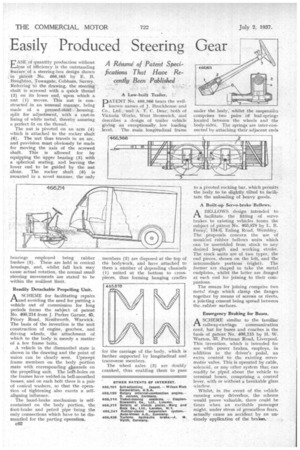Easily Produced Steering Gear
Page 108

If you've noticed an error in this article please click here to report it so we can fix it.
A Rdsurni of Patent Spedfications That Have Recently Been Published
EASE of quantity production without
• ,i_aloss of efficiency is the outstanding _feature of a steering-box design shown ; in pathat No. 466,165 by E. B. Boughton, Towngate, Cobham, Surrey. Referring to the drawing, the steering shaft is screwed with a, quick thread (2) on its lower end, upon which a nut (1) moves. This nut is constructed in an unusual manner, being made of a pressed-Steel housing, split for adjustment, with a cast-in lining of white metal, thereby assuring a perfect fit on the thread, The nut is pivoted on an arm (4) which is attached to the rocker shaft (6). The nut thus travels in an arc, and provision must obviously be made for moving the axis of the screwed Shaft. This is allowed for by equipping the upper bearing (3) with a spherical seating, and leaving the lower end to he guided by the nut alone, The rocker shaft (6) is mounted in a novel manner, the only bearings employed being rubber bushes (5). These are held in conical housings, and, whilst full lock may cause actual rotation, the normal small steering movements are stated to be within the resilient limit.
Readily Detachable Propelling Unit.
A SCHEME for facilitating repairs I-land avoiding the need for putting a vehicle out of commission for long periods forms the subject of patent No. 466,214 from J. Parker Garner, 45, Priory Road, Kenilworth, Warwick. The basis of the invention is the unit construction of engine, gearbox, and driving wheels, the attachment of which to the body is, merely a matter of a few frame bolts.
A vehicle in the dismantled state is shown in the drawing and the point of union can, be clearly seen. Upswept frame members on the body portion mate with corresponding -4annels on the propelling unit. The belt-holes on the frames have welded-in bell-mouthed bosses, and on each bolt there is a pair of conical washers, so that the operation of tightening also exerts a selfaligning influence.
The hand-brake mechanism is selfcontained on the body portion, the font-brake and petrol pipe being the only connections which have to be dismantled for the parting operation.
e62 A Low.built Trailer.
PATNT No. 466,366 bears the wellknown names of J. Brockhouse and Co., Ltd., 'and A. T. C. Dear, both of Victoria Works, West Bromwich, and describes a design of trailer vehicle giving • an exceptionally low loading
level, The main longitudinal frame members (2) are disposed at the top of the bodywork, and have attached to them a number of depending channels (1) united at the bottom to crosspieces, thus forming hanging cradles
for the carriage of the body, which is further supported by longitudinal and transverse members.
The wheel axles (3) are doubly cranked, thus enabling them to pass under the body, whilst the suspensgm comprises two pairs Of leaf-springs located between the wheels and the body-sides. The springs are inter-connected by attaching their adjacent ends to a pivoted rocking bar, which permits the body to be slightly tilted to facilitate the unloading of heavy goods.
A Built-up Servo-brake Bellows.
ABELLOWS. design intended to facilitate the fitting of servo brakes to existing vehicles forms the subject of patent. No. 465,878 by L. B. Feeriy1 1:44-13., Ealing Road, Wembley. The proposals concern the use of moulded rubber bellows units which can be assembled from stock to any desired length and working stroke. The stock units are of two types, the end pieces, shown on the left, and the intermediate portions. (right). The former are shaped to take the metal endplates, whilst the latter are flanged at each end for joining to their companions.
The means for joining comprise two metal rings which clamp the flanges together by means of screws or rivets, a jointing cement being spread between the. rubber surfaces.
Emergency l3raking for Buses.
ASCHEME similar to the familiar railway-carriage • communication cord, bat for buses and coaches is the basis of patent No, 466,1/5 by H. W. Warton, 33', Portman Road, Liverpool. This invention, which is intended for use with power brakes, employs, in addition to the driver's pedal, an extra control to the existing servomotor valve. This is operated by. cable, solenoid, or any other system that can readily be piped about the vehicle to terminal boxes, comprising a control lever, with or without a breakable glass window.
Whilst, in the event of the vehicle running away driverless, the scheme would prove valuable, there could be times when an excitable passenger might, under stress of groundless fears, actually cause an accident by an untimely application of the brake's.




















































































































































